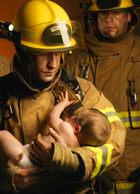Flame Retardants: Why Policy Changes Are Needed
Children have 4-5 times the level of exposures to flame-retardants as adults due to their small body size. However, TDCPP, or "Tris," is a widely used flame retardant added to foam in furniture as well as many baby products. According to a 2011 study looking at the presence of various flame retardants in baby products, TDCPP was the most common flame retardant added to infant products. Flame-retardants cross the placenta and therefore get into the cord blood of fetuses. The ensuing baby gets another dose of flame-retardants through the mother's milk. And then the infant gets exposed again because most infant products, such as their mattresses, changing tables, nursing pillows, baby carriers, and car seats all contain the flame retardant "tris" - a known carcinogen. The flame retardant story is one of substituting one harmful flame retardant for another - and then that one ends up equally harmful. This continues because flame retardants are poorly tested, if tested at all, before they enter the market place. Some flame-retardants are neuro-toxic, some are carcinogenic, some some are hormone disrupters and some affect the thyroid gland. Penta BDE was widely used in the 1980's, substituing and earlier one that was found harmful - then it was phased out in 2005 because it too was found harmful to health. It was found to be bioacccumlative, affect the thyroid gland, the immune system and had the ability to be a neurotoxin. Now FireMaster 550 has replaced it. NIH has found Firemaster 550 to be an endocrine disrupter. It has not been tested for its ability to cause cancer, affect reproduction or neurological development. Flame-retardants are in almost all consumer products: couches, chairs, mattresses, T.V.s, computers, and all the infant products mentioned above. Products that contain flame-retardants are not labeled - therefore consumers cannot protect themselves from flame-retardant exposures. Firefighters have 3 times the levels of flame-retardants in their blood as the general public.
Recent toxicological studies demonstrate that flame-retardants pose the greatest risk to the normal growth and development of fetuses, infants and children. Flame retardants should only be used in "high-risk" situations, such as airplanes, cars, trains, etc.
Flame-retardants should not be used in "low-risk" situations – as the risk for flame-retardant exposures out-weighs the risk from fire. 
